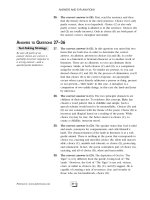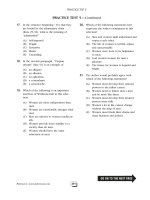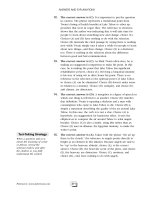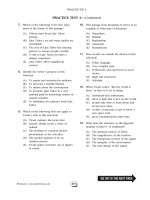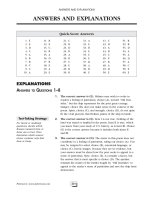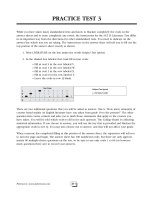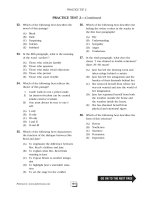SAT II Physics (SN) Episode 2 Part 1 pptx
Bạn đang xem bản rút gọn của tài liệu. Xem và tải ngay bản đầy đủ của tài liệu tại đây (1.2 MB, 25 trang )
Asphalt, like most materials, has a positive coefficient of linear expansion, meaning that it expands as
temperatures rise in summer and shrinks as temperatures fall in winter. This effect is called the law of
thermal expansion, D. The gaps in the sidewalk allow the blocks to expand without pushing against each
other and cracking.
4. E
Convection is a form of heat transfer where a large number of molecules move from one place to another. An
overhead fan works precisely by this method: it sends cooler air molecules down into a hot room, cooling the
temperature of the room. The heat of the sun and the cooking action of a microwave are both forms of
radiation, while the heat on a frying pan and the cooling action of ice cubes are both forms of conduction.
5. A
Since the gas is in a closed container, its volume remains constant, so the correct answer is A.
When the gas is heated, its temperature increases, meaning that the average speed of the gas molecules
increases. An increase in temperature also means there are more collisions between molecules.
According to the ideal gas law, when volume is constant and temperature is increased, then pressure will
also increase. Pressure is determined by the rate of collisions of the gas molecules with the walls of the
container.
6. A
According to the ideal gas law, temperature is directly proportional to volume and pressure. Since the volume
of the container is constant, that means that doubling the temperature will double the pressure.
R
is a constant: it doesn’t vary under different circumstances, so C is wrong. Also, we are looking at a
random sample of the gas, so there won’t be a heavier isotope in one or the other of the containers: E is also
wrong.
7. D
The ideal gas law states that temperature is directly proportional to pressure and volume. Since the gas is in
a closed container, the volume is fixed, so an increase in temperature leads to an increase in pressure. The
correct answer is D.
The atomic mass and the number of molecules are fixed properties of the gas sample, and cannot change
with heat. The density depends on the mass and the volume. The mass is also a fixed property of the gas
sample, and the volume is being held constant, since we are dealing with a closed container. Therefore, the
density must also remain constant. Because the number of molecules and the volume are constant, the
average space between the molecules must remain constant.
201
8. D
The First Law of Thermodynamics tells us that : the change in internal energy is equal to
the change in heat plus the work done on the system. The value of is 24 J, since that much heat is
added to the system, and the value of is –6 J, since the system does work rather than has work done
on it. With this in mind, calculating is a simple matter of subtraction:
9. E
The Second Law of Thermodynamics tells us that the total amount of disorder, or entropy, in the universe is
increasing. The entropy in a particular system can decrease, as with water molecules when they turn to ice,
but only if the entropy in the surroundings of that system increases to an equal or greater extent. The
Second Law of Thermodynamics holds, but only because the surroundings are gaining entropy, so the correct
answer is E. Answer D refers to the key part of the answer, but gives the wrong information about the
change in entropy of the surroundings.
Be careful not to fall for answer C. This is an explanation for why the water does not lose heat when it
freezes: it is, in fact, losing internal energy. This is an instance of the First Law of Thermodynamics, which
states that the change in a system’s internal energy is equal to the value of the heat transfer in the system
minus the work done by the system.
10. E
The efficiency of a heat engine is defined as , where is the amount of heat
output into the cold reservoir and is the amount of heat produced by the heat engine. Plugging the
numbers in the question into this formula, we find that:
An efficiency of 0.3 is the same thing as 30%.
Electric Forces, Fields, and Potential
DEMOCRITUS, A GREEK PHILOSOPHER OF the 5th century B.C., was the first to propose
that all things are made of indivisible particles called atoms. His hypothesis was only half right.
202
The things we call atoms today are in fact made up of three different kinds of particles: protons,
neutrons, and electrons. Electrons are much smaller than the other two particles. Under the
influence of the electronic force, electrons orbit the nucleus of the atom, which contains protons
and neutrons.
Protons and electrons both carry electric charge, which causes them to be attracted to one
another. In most atoms, there are as many electrons as there are protons, and the opposite charges
of these two kinds of particle balance out. However, it is possible to break electrons free from their
orbits about the nucleus, causing an imbalance in charge. The movement of free electrons is the
source of everything that we associate with electricity, a phenomenon whose power we have
learned to harness over the past few hundred years to revolutionary effect.
Electric Charge
It is very difficult, if not impossible, to understand fully what electric charge, q, is. For SAT II
Physics, you need only remember the old phrase: opposites attract. Protons carry a positive charge
and electrons carry a negative charge, so you can just remember these three simple rules:
•
Two positive charges will repel one another.
•
Two negative charges will repel one another.
•
A positive charge and a negative charge will attract one another.
The amount of positive charge in a proton is equal to the amount of negative charge in an electron,
so an atom with an equal number of protons and electrons is electrically neutral, since the positive
and negative charges balance out. Our focus will be on those cases when electrons are liberated
from their atoms so that the atom is left with a net positive charge and the electron carries a net
negative charge somewhere else.
Conservation of Charge
The SI unit of charge is the coulomb (C). The smallest unit of charge, e—the charge carried by a
proton or an electron—is approximately C. The conservation of charge—a hypothesis
first put forward by Benjamin Franklin—tells us that charge can be neither created nor destroyed.
The conservation of charge is much like the conservation of energy: the net charge in the universe
is a constant, but charge, like energy, can be transferred from one place to another, so that a given
system experiences a net gain or loss of charge. Two common examples of charge being
transferred from one place to another are:
1. Rubbing a rubber rod with a piece of wool: The rod will pull the electrons off the wool,
so that the rubber rod will end up with a net negative charge and the wool will have a net
positive charge. You’ve probably experienced the “shocking” effects of rubbing rubber-
soled shoes on a wool carpet.
2. Rubbing a glass rod with a piece of silk: The silk will pull the electrons off the glass, so
that the glass rod will end up with a net positive charge and the silk will have a net
203
negative charge.
Remember, net charge is always conserved: the positive charge of the wool or glass rod will
balance out the negative charge of the rubber rod or silk.
The Electroscope
The electroscope is a device commonly used—and sometimes included on SAT II Physics—to
demonstrate how electric charge works. It consists of a metal bulb connected to a rod, which in
turn is connected to two thin leaves of metal contained within an evacuated glass chamber. When a
negatively charged object is brought close to the metal bulb, the electrons in the bulb are repelled
by the charge in the object and move down the rod to the two thin leaves. As a result, the bulb at
the top takes on a positive charge and the two leaves take on a negative charge. The two metal
leaves then push apart, as they are both negatively charged, and repel one another.
When a positively charged object approaches the metal bulb, the exact opposite happens, but with
the same result. Electrons are drawn up toward the bulb, so that the bulb takes on a negative
charge and the metal leaves have a positive charge. Because both leaves still have the same
charge, they will still push apart.
Electric Force
There is a certain force associated with electric charge, so when a net charge is produced,
a net electric force is also produced. We find electric force at work in anything that runs
on batteries or uses a plug, but that isn’t all. Almost all the forces we examine in this book
come from electric charges. When two objects “touch” one another—be it in a car crash or
a handshake—the atoms of the two objects never actually come into contact. Rather, the
atoms in the two objects repel each other by means of an electric force.
Coulomb’s Law
Electric force is analogous to gravitational force: the attraction or repulsion between two
particles is directly proportional to the charge of the two particles and inversely
proportional to the square of the distance between them. This relation is expressed
mathematically as Coulomb’s Law:
In this equation, and are the charges of the two particles, r is the distance between
them, and k is a constant of proportionality. In a vacuum, this constant is Coulumb’s
constant, , which is approximately N · m
2
/ C
2
. Coulomb’s constant is often
expressed in terms of a more fundamental constant—the permittivity of free space,
, which has a value of C
2
/ N · m
2
:
204
If they come up on SAT II Physics, the values for and will be given to you, as will any
other values for k when the electric force is acting in some other medium.
EXAMPLE
Two particles, one with charge +q and the other with charge –q, are a distance r apart. If the
distance between the two particles is doubled and the charge of one of the particles is
doubled, how does the electric force between them change?
According to Coulomb’s Law, the electric force between the two particles is initially
If we double one of the charges and double the value of r, we find:
Doubling the charge on one of the particles doubles the electric force, but doubling the
distance between the particles divides the force by four, so in all, the electric force is half
as strong as before.
Superposition
If you’ve got the hang of vectors, then you shouldn’t have too much trouble with the law
of superposition of electric forces. The net force acting on a charged particle is the
vector sum of all the forces acting on it. For instance, suppose we have a number of
charged particles, , , and . The net force acting on is the force exerted on it by
added to the force exerted on it by . More generally, in a system of n particles:
where is the force exerted on particle 1 by particle n and is the net force acting on
particle 1. The particle in the center of the triangle in the diagram below has no net force
acting upon it, because the forces exerted by the three other particles cancel each other
out.
205
EXAMPLE
In the figure above, what is the direction of the force acting on particle A?
The net force acting on A is the vector sum of the force of B acting on A and the force of C
acting on A. Because they are both positive charges, the force between A and B is
repulsive, and the force of B on A will act to push A toward the left of the page. C will have
an attractive force on A and will pull it toward the bottom of the page. If we add the
effects of these two forces together, we find that the net force acting on A is diagonally
down and to the left.
Electric Field
An electric charge, q, can exert its force on other charged objects even though they are
some distance away. Every charge has an electric field associated with it, which exerts
an electric force over all charges within that field. We can represent an electric field
graphically by drawing vectors representing the force that would act upon a positive point
charge placed at that location. That means a positive charge placed anywhere in an
electric field will move in the direction of the electric field lines, while a negative charge
206
will move in the opposite direction of the electric field lines. The density of the resulting
electric field lines represents the strength of the electric field at any particular point.
Calculating Electric Field
The electric field is a vector field: at each point in space, there is a vector corresponding to
the electric field. The force F experienced by a particle q in electric field E is:
Combining this equation with Coulomb’s Law, we can also calculate the magnitude of the
electric field created by a charge q at any point in space. Simply substitute Coulomb’s Law
in for , and you get:
Drawing Electric Field Lines
SAT II Physics may ask a question about electric fields that involves the graphical
representation of electric field lines. We saw above how the field lines of a single point
charge are represented. Let’s now take a look at a couple of more complicated cases.
Electric Fields for Multiple Charges
Just like the force due to electric charges, the electric field created by multiple charges is
the sum of the electric fields of each charge. For example, we can sketch the electric field
due to two charges, one positive and one negative:
207
Line Charges and Plane Charges
Suppose we had a line of charge, rather than just a point charge. The electric field
strength then decreases linearly with distance, rather than as the square of the distance.
For a plane of charge, the field is constant with distance.
Electric Potential
Because the electric force can displace charged objects, it is capable of doing work. The
presence of an electric field implies the potential for work to be done on a charged object.
By studying the electric potential between two points in an electric field, we can learn a
great deal about the work and energy associated with electric force.
Electric Potential Energy
Because an electric field exerts a force on any charge in that field, and because that force
causes charges to move a certain distance, we can say that an electric field does work on
charges. Consequently, we can say that a charge in an electric field has a certain amount
of potential energy, U. Just as we saw in the chapter on work, energy, and power, the
potential energy of a charge decreases as work is done on it:
208
Work
The work done to move a charge is the force, F, exerted on the charge, multiplied by the
displacement, d, of the charge in the direction of the force. As we saw earlier, the
magnitude of the force exerted on a charge q in an electric field E is = qE. Thus, we can
derive the following equation for the work done on a charge:
Remember that d is not simply the displacement; it is the displacement in the direction
that the force is exerted. When thinking about work and electric fields, keep these three
rules in mind:
1. When the charge moves a distance r parallel to the electric field lines, the work
done is qEr.
2. When the charge moves a distance r perpendicular to the electric field lines, no
work is done.
3. When the charge moves a distance r at an angle to the electric field lines, the
work done is qEr cos .
EXAMPLE
209
In an electric field, E, a positive charge, q, is moved in the circular path described above,
from point A to point B, and then in a straight line of distance r toward the source of the
electric field, from point B to point C. How much work is done by the electric field on the
charge? If the charge were then made to return in a straight line from point C to point A,
how much work would be done?
HOW MUCH WORK IS DONE MOVING THE CHARGE FROM POINT
A TO POINT B TO POINT C
?
The path from point A to point B is perpendicular to the radial electric field throughout,
so no work is done. Moving the charge from point B to point C requires a certain amount
of work to be done against the electric field, since the positive charge is moving against its
natural tendency to move in the direction of the electric field lines. The amount of work
done is:
The negative sign in the equation reflects the fact that work was done against the electric
field.
HOW MUCH WORK IS DONE MOVING THE CHARGE DIRECTLY
FROM POINT C BACK TO POINT A?
The electric force is a conservative force, meaning that the path taken from one point in
the electric field to another is irrelevant. The charge could move in a straight line from
point C to point A or in a complex series of zigzags: either way, the amount of work done
by the electric field on the charge would be the same. The only thing that affects the
amount of work done is the displacement of the charge in the direction of the electric field
lines. Because we are simply moving the charge back to where it started, the amount of
work done is W = qEr.
Potential Difference
210
Much like gravitational potential energy, there is no absolute, objective point of reference
from which to measure electric potential energy. Fortunately, we are generally not
interested in an absolute measure, but rather in the electric potential, or potential
difference, V, between two points. For instance, the voltage reading on a battery tells us
the difference in potential energy between the positive end and the negative end of the
battery, which in turn tells us the amount of energy that can be generated by allowing
electrons to flow from the negative end to the positive end. We’ll look at batteries in more
detail in the chapter on circuits.
Potential difference is a measure of work per unit charge, and is measured in units of
joules per coulomb, or volts (V). One volt is equal to one joule per coulomb.
Potential difference plays an important role in electric circuits, and we will look at it more
closely in the next chapter.
Conductors and Insulators
Idealized point charges and constant electric fields may be exciting, but, you may ask,
what about the real world? Well, in some materials, such as copper, platinum, and most
other metals, the electrons are only loosely bound to the nucleus and are quite free to
flow, while in others, such as wood and rubber, the electrons are quite tightly bound to
the nucleus and cannot flow. We call the first sort of materials conductors and the
second insulators. The behavior of materials in between these extremes, called
semiconductors, is more complicated. Such materials, like silicon and germanium, are
the basis of all computer chips.
In a conductor, vast numbers of electrons can flow freely. If a number of electrons are
transmitted to a conductor, they will quickly distribute themselves across the conductor
so that the forces between them cancel each other out. As a result, the electric field within
a conductor will be zero. For instance, in the case of a metal sphere, electrons will
distribute themselves evenly so that there is a charge on the surface of the sphere, not
within the sphere.
Key Formulas
Coulomb’s
Law
The Law of
Superpositio
n
211
Definition of
the Electric
Field
Electric
Potential
Energy
Work Done
by an
Electric Field
Electric
Potential
Practice Questions
1. . When a long-haired woman puts her hands on a Van de Graaff generator—a large
conducting sphere with charge being delivered to it by a conveyer belt—her hair stands
on end. Which of the following explains this phenomenon?
(A) Like charges attract
(B) Like charges repel
(C) Her hair will not stand on end
(D) Her body is conducting a current to the ground
(E) The Van de Graaf generator makes a magnetic field that draws her hair up on end
2. . Three particles, A, B, and C, are set in a line, with a distance of d between each of them,
as shown above. If particle B is attracted to particle A, what can we say about the charge,
, of particle A?
(A)
< –q
(B)
–q < < 0
(C)
= 0
(D)
0 < < +q
(E)
> +q
212
3. . A particle of charge +2q exerts a force F on a particle of charge –q. What is the force
exerted by the particle of charge –q on the particle of charge +2q?
(A)
1
/
2
F
(B) 0
(C) 2F
(D) F
(E) –F
4. . Two charged particles exert a force of magnitude F on one another. If the distance
between them is doubled and the charge of one of the particles is doubled, what is the
new force acting between them?
(A)
1
/
4
F
(B)
1
/
2
F
(C) F
(D) 2F
(E) 4F
213
5. . Four charged particles are arranged in a square, as shown above. What is the direction of
the force acting on particle A?
(A)
(B)
(C)
(D)
(E)
6. . Two identical positive charges of +Q are 1 m apart. What is the magnitude and direction
of the electric field at point A, 0.25 m to the right of the left-hand charge?
(A)
3
/
4
kQ to the right
(B)
128
/
9
kQ to the left
(C)
160
/
9
kQ to the left
(D)
160
/
9
kQ to the right
(E)
128
/
9
kQ to the right
214
7. . A particle of charge +q is a distance r away from a charged flat surface and experiences a
force of magnitude F pulling it toward the surface. What is the magnitude of the force
exerted on a particle of charge +q that is a distance 2r from the surface?
(A)
1
/
8
F
(B)
1
/
4
F
(C)
1
/
2
F
(D) F
(E) 2F
8. . What is the change in potential energy of a particle of charge +q that is brought from a
distance of 3r to a distance of 2r by a particle of charge –q?
(A)
(B)
(C)
(D)
(E)
9. . Two charges are separated by a distance d. If the distance between them is doubled, how
does the electric potential between them change?
(A) It is doubled
(B) It is halved
(C) It is quartered
(D) It is quadrupled
(E) It is unchanged
10. . A solid copper sphere has a charge of +Q on it. Where on the sphere does the charge
reside?
(A) +Q at the center of the sphere
(B) Q/2 at the center of the sphere and Q/2 on the outer surface
(C) –Q at the center of the sphere and +2Q on the outer surface
(D) +Q on the outer surface
(E) The charge is spread evenly throughout the sphere
Explanations
215
1. B
Charge (either positive or negative) is brought to the woman by the Van de Graaf generator. This charge
then migrates to the ends of her hair. The repulsive force between like charges makes the hair separate and
stand on end. A violates Columbs Law. D and E do not explain the phenomenon.
2. E
Particle C exerts an attractive force on the negatively charged particle B. If B is to be pulled in the direction
of A, A must exert an even stronger attractive force than particle C. That means that particle A must have a
stronger positive charge than particle C, which is +q.
3. E
The electric force exerted by one charged particle on another is proportional to the charge on both particles.
That is, the force exerted by the +2q particle on the –q particle is of the same magnitude as the force
exerted by the –q particle on the +2q particle, because, according to Coulomb’s Law, both forces have a
magnitude of:
Since one particle is positive and the other is negative, this force is attractive: each particle is pulled toward
the other. Since the two particles are pulled toward each other, the forces must be acting in opposite
directions. If one particle experiences a force of F, then the other particle must experience a force of –F.
4. B
Coulomb’s Law tells us that : the force between two particles is directly proportional to their
charges and inversely proportional to the square of the distance between them. If the charge of one of the
particles is doubled, then the force is doubled. If the distance between them is doubled, then the force is
divided by four. Since the force is multiplied by two and divided by four, the net effect is that the force is
halved.
5. C
Particles C and D exert a repulsive force on A, while B exerts an attractive force. The force exerted by D is
somewhat less than the other two, because it is farther away. The resulting forces are diagrammed below:
216
The vector sum of the three vectors will point diagonally up and to the right, as does the vector in C.
6. E
The vector for electric field strength at any point has a magnitude of and points in the
direction that a positive point charge would move if it were at that location. Because there are two different
point charges, and , there are two different electric fields acting at point A. The net electric field at A
will be the vector sum of those two fields. We can calculate the magnitude of the electric field of each charge
respectively:
Since both and would exert a repulsive force on a positive point charge, points to the right and
points to the left. The net electric field is:
Because is closer to A than , the electric field from will be stronger than the electric field from
, and so the net electric field will point to the right.
7. D
The charged surface is a plane charge, and the electric field exerted by a plane charge is E = kq. That is, the
magnitude of the electric field strength does not vary with distance, so a particle of charge +q will experience
the same attractive force toward the charged surface no matter how far away it is.
217
8. B
The change in potential energy of a point particle, with reference to infinity is given by:
The difference in potential energy between two points is given by:
9. B
The electric potential of a charge is given by the equation V = kq/r. In other words, distance is inversely
proportional to electric potential. If the distance is doubled, then the electric potential must be halved.
10. D
Excess charges always reside on the surface of a conductor because they are free to move, and feel a
repulsive force from each other.
DC Circuits
IN THE PREVIOUS CHAPTER, WE LOOKED AT the movement of charges, showing that
a net charge creates an electric field with differences in electric potential energy at
different points in the field. When two points in a field with a potential difference are
connected by a conducting material, electrons will flow spontaneously from one point to
another. For instance, when the two terminals of a battery (a source of potential
difference) are connected by a copper wire (a conducting material), electrons flow
spontaneously from the negative terminal of the battery toward the positive terminal.
This mass flow of electrons in a particular direction creates a current, which is the
source of the circuits that we will examine in this chapter.
As fans of hard rock know, there are two kinds of circuits, AC and DC. AC stands for
alternating current: an electromagnetic generator induces a current that alternates in
direction. AC circuits can be quite complicated, so you’ll be relieved to know this is the
last you’ll hear of them: they don’t appear on SAT II Physics. However, you should expect
a good number of questions on DC, or direct current, circuits. These are the more familiar
circuits, where a current flows steadily in a single direction.
218
Voltage
The batteries we use in flashlights and clock radios operate on chemical energy. This
chemical energy—which you may learn more about in chemistry class—separates charges,
creating a potential difference. To separate charges and create a positive and negative
terminal, the battery must do a certain amount of work on the charges. This work per unit
charge is called the voltage, V, or electromotive force, emf, and is measured in volts
(V). Remember, one volt is equal to one joule per coulomb.
You’ll notice that voltage is measured in the same units as potential difference. That’s
because they are essentially the same thing. The voltage of a battery is a measure of the
work that has been done to set up a potential difference between the two terminals. We
could draw an analogy to the amount of work required to lift an object in the air, giving it
a certain amount of gravitational potential energy: both work and gravitational potential
energy are measured in joules, and the amount of work done on the object is exactly equal
to the amount of gravitational potential energy it acquires.
When a current flows about a circuit, we say there is a certain “voltage drop” or “drop in
potential” across the circuit. An electric current converts potential energy into work: the
electric field in the circuit does work on the charges to bring them to a point of lower
potential. In a circuit connected to a 30 V battery, the current must drop 30 volts to send
the electrons from the negative terminal to the positive terminal.
Current
When a wire is connected between the terminals of a battery, the potential difference in
the battery creates an electric field in the wire. The electrons at the negative terminal
move through the wire to the positive terminal.
Although the electrons in the wire move quickly, they go in random directions and collide
with other electrons and the positive charges in the wire. Each electron moves toward the
positive terminal at a speed , called the drift speed, which is only about one
millimeter per second. However, when we study circuits, we do not follow individual
electrons as they move along the wire, but rather we look at the current, I, that they
create. Current is the charge per unit time across an imaginary plane in the wire:
219
The unit of current is the coulomb per second, which is called an ampere (A): 1 A =
1 C/s.
Direction of Current
Although the electrons are the charge carriers and move from the negative terminal to the
positive terminal of the battery, the current flows in the opposite direction, from the
positive terminal to the negative terminal. This may seem odd, but we can draw an
analogous example from everyday life. Suppose you arrange 12 chairs in a circle, and get
11 people to sit down, leaving one chair empty. If each person in turn were to shift over in
the clockwise direction to fill the vacant spot, the vacant spot would appear to move in the
counterclockwise direction. If we think of the electrons in a circuit as the people, then the
current moves in the direction of the vacant spot.
Resistance
Some materials conduct current better than others. If we had a copper wire and a glass
wire with the same length and cross section, and put the same potential difference across
them, the current in the copper wire would be much larger than the current in the glass
wire. The structure of copper, a conductor, is such that it permits electrons to move about
more freely than glass, an insulator. We say that the glass wire has a higher resistance,
R, than the copper wire.
We can express resistance in terms of the potential difference, , and the current, I:
Generally, the is omitted. For a given voltage, the larger the current, the smaller the
resistance. The unit of resistance is the ohm ( ). One ohm is equal to one volt per
ampere: 1 = 1 V/A.
Ohm’s Law
Ohm’s Law relates the three important quantities of current, voltage, and resistance:
220
This equation tells us that we can maximize the current by having a large voltage drop
and a small resistance. This is one of the most important equations dealing with
electromagnetism, and SAT II Physics is bound to call upon you to remember it.
EXAMPLE
Three batteries are added to a circuit, multiplying the potential difference in the circuit by
four. A resistor is also added, doubling the resistance of the circuit. How is the current in
the wire affected?
Taking the initial voltage to be V and the initial resistance to be R, the initial current is
= V/R. The new voltage is 4V and the new resistance is 2R, so the final current is:
These changes double the current.
Resistivity
Resistivity, , is a property of a material that affects its resistance. The higher the
resistivity, the higher the resistance. Resistance also depends on the dimensions of the
wire—on its length, L, and cross-sectional area, A:
A longer wire provides more resistance because the charges have farther to go. A larger
cross-sectional area reduces the resistance because it is easier for the charges to move.
The unit of resistivity is the ohm-meter, · m. The resistivity of copper is about 10
–8
·
m and the resistivity of glass is about 10
12
· m. At higher temperatures, the resistivity of
most metals increases.
EXAMPLE
A copper wire of length 4 m and cross-sectional area 4 mm
2
is connected to a battery with a
potential difference of 9 V. What is the current that runs through the wire? Approximate the
resistivity for copper to be 10
–8
· m.
As we know, the current in a wire is a measure of voltage divided by resistance. We know
that the voltage for the circuit is 9 V, but we don’t know the resistance. However, since we
know that the resistivity for copper is 10
–8
· m, we can use the formula for resistivity to
calculate the resistance in the wire.
First, we need to remember that area is measured in m
2
, not mm
2
. If 1 mm = m,
then 4 mm
2
= = m
2
.
221
Now we can plug the values for the resistivity of copper and the length and cross-
sectional area of the wire into the equation for resistivity:
Once we know the resistance of the circuit, calculating the current involves a simple
application of Ohm’s Law:
Conductivity
Infrequently, you may come across talk of conductivity and conductance rather than
resistivity and resistance. As the names suggest, these are just the inverse of their
resistant counterparts. Saying a material has high conductivity is another way of saying
that material has a low resistivity. Similarly, a circuit with high conductance has low
resistance. Someone with half a sense of humor named the unit of conductance the mho (
), where 1 = 1 .
Energy, Power, and Heat
As a charge carrier moves around a circuit and drops an amount of potential, V, in time t,
it loses an amount of potential energy, qV. The power, or the rate at which it loses energy,
is qV/t. Since the current, I, is equal to q/t, the power can be expressed as:
The unit of power is the watt (W). As you learned in Chapter 4, one watt is equal to one
joule per second.
VIR and PIV Triangles
Ohm’s Law and the formula for power express fundamental relationships between power,
current, and voltage, and between voltage, current, and resistance. On occasion, you may
be asked to calculate any one of the three variables in these equations, given the other
two. As a result, good mnemonics to remember are the VIR and PIV triangles:
222
If the two variables you know are across from one another, then multiplying them will get
you the third. If the two variables you know are above and below one another, then you
can get the third variable by dividing the one above by the one below. For instance, if you
know the power and the voltage in a given circuit, you can calculate the current by
dividing the power by the voltage.
Power and Resistance
We can combine the equations for power and Ohm’s Law to get expressions for power in
terms of resistance:
Heat
As current flows through a resistor, the resistor heats up. The heat in joules is given by:
where t is the time in seconds. In other words, a resistor heats up more when there is a
high current running through a strong resistor over a long stretch of time.
EXAMPLE
A circuit with a potential difference of 10 V is hooked up to a light bulb whose resistance is
20 . The filament in the light bulb heats up, producing light. If the light bulb is left on for
one minute, how much heat is produced?
We are being asked for the amount of heat that is dissipated, which is the product of
power and time. We have learned to express power in terms of voltage and resistance in
the formula P = V
2
/R. Applying that formula to the problem at hand, we find:
Then, plugging the appropriate numbers into the equation for heat, we find:
Every minute, the filament produces 300 J of heat.
Kilowatt-Hours
When electric companies determine how much to charge their clients, they measure the
power output and the amount of time in which this power was generated. Watts and
seconds are relatively small units, so they measure in kilowatt-hours, where one kilowatt
is equal to 1000 watts. Note that the kilowatt-hour, as a measure of power multiplied by
time, is a unit of energy. A quick calculation shows that:
223
Circuits
Most SAT II Physics questions on circuits will show you a circuit diagram and ask you
questions about the current, resistance, or voltage at different points in the circuit. These
circuits will usually consist of a power source and one or more resistors arranged in
parallel or in series. You will occasionally encounter other circuit elements, such as a
voltmeter, an ammeter, a fuse, or a capacitor. Reading the diagrams is not difficult, but
since there will be a number of questions on the test that rely on diagrams, it’s important
that you master this skill. Here’s a very simple circuit diagram:
Zigzags represent resistors, and a pair of parallel, unequal lines represents a battery cell.
The longer line is the positive terminal and the shorter line is the negative terminal. That
means the current flows from the longer line around the circuit to the shorter line. In the
diagram above, the current flows counterclockwise. Often, more than one set of unequal
parallel lines are arranged together; this just signifies a number of battery cells arranged
in series.
Example
In the diagram above, = 6 V and R = 12 . What is the current in the circuit and what is
the power dissipated in the resistor?
You don’t really need to refer to the diagram in order to solve this problem. As long as
you know that there’s a circuit with a six-volt battery and a 12-ohm resistor, you need
only apply Ohm’s Law and the formula for power.
Since I = V/R, the current is:
The power is:
Resistors in Series
Two resistors are in series when they are arranged one after another on the circuit, as in
the diagram below. The same amount of current flows first through one resistor and then
the other, since the current does not change over the length of a circuit.
224
However, each resistor causes a voltage drop, and if there is more than one resistor in the
circuit, the sum of the voltage drops across each resistor in the circuit is equal to the total
voltage drop in the circuit. The total resistance in a circuit with two or more resistors in
series is equal to the sum of the resistance of all the resistors: a circuit would have the
same resistance if it had three resistors in series, or just one big resistor with the
resistance of the original three resistors put together. In equation form, this principle is
quite simple. In a circuit with two resistors, and , in series, the total resistance,
is:
EXAMPLE
In the figure above, a battery supplies 30 V to a circuit with a 10 resistor and a 20
resistor. What is the current in the circuit, and what is the voltage drop across each resistor?
WHAT IS THE CURRENT IN THE CIRCUIT?
We can determine the current in the circuit by applying Ohm’s Law: I = V/R. We know
what V is, but we need to calculate the total resistance in the circuit by adding together
the individual resistances of the two resistors in series:
When we know the total resistance in the circuit, we can determine the current through
the circuit with a simple application of Ohm’s Law:
WHAT IS THE VOLTAGE DROP ACROSS EACH RESISTOR?
Determining the voltage drop across an individual resistor in a series of resistors simply
requires a reapplication of Ohm’s Law. We know the current through the circuit, and we
know the resistance of that individual resistor, so the voltage drop across that resistor is
225



